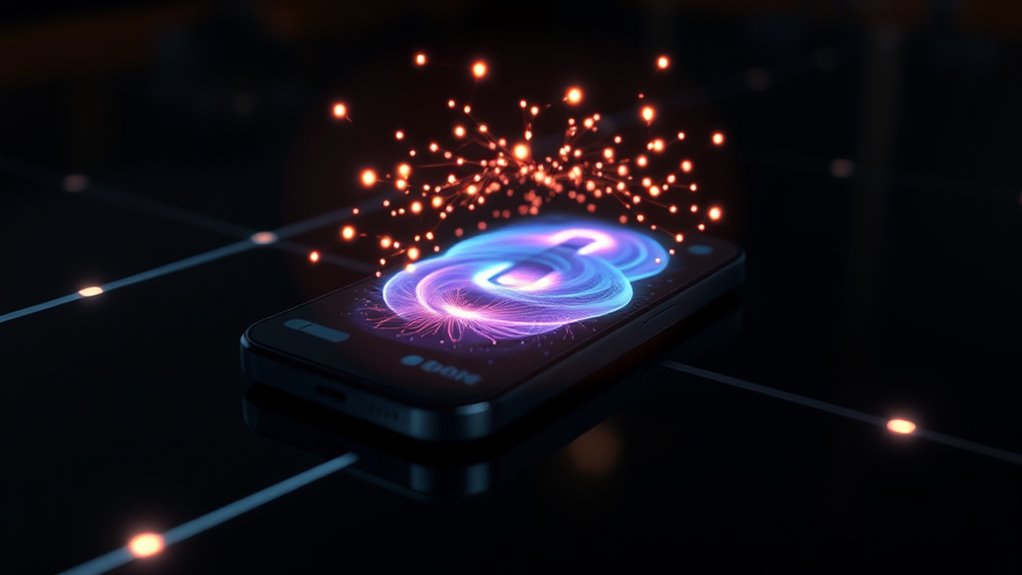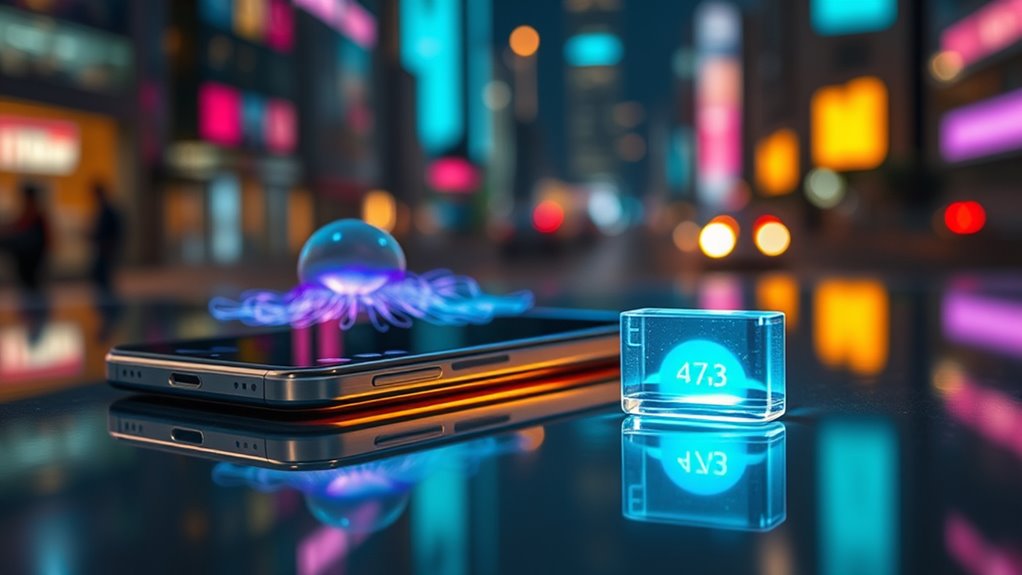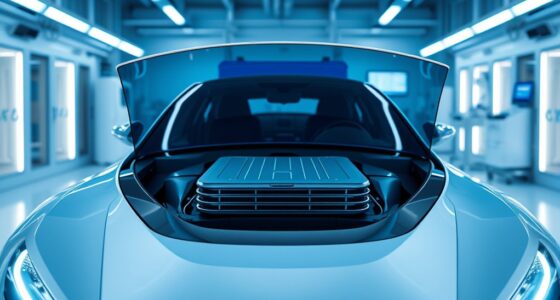Quantum batteries use quantum entanglement to transfer energy incredibly fast, potentially allowing your phone to charge in seconds by 2030. Unlike traditional batteries, they manipulate quantum states for efficient, rapid energy sharing, cutting down charging times dramatically. While still in experimental stages, advances in quantum technology suggest this could become a reality soon. If you stay curious, you’ll discover how these groundbreaking systems might soon change the way we power our devices forever.
Key Takeaways
- Quantum batteries utilize quantum entanglement to enable rapid energy transfer, potentially charging devices in seconds.
- Advances in quantum technology aim to overcome current stability and coherence challenges for practical implementation.
- Theoretical models suggest quantum batteries could significantly reduce charging times for smartphones by 2030.
- Practical deployment depends on developing robust materials and error correction techniques to maintain quantum states.
- While promising, quantum batteries are still experimental, and widespread adoption for consumer electronics by 2030 remains uncertain.

Quantum batteries are a groundbreaking development in energy storage technology that leverage the principles of quantum mechanics to achieve faster charging times and higher efficiencies. Unlike traditional batteries, which store energy chemically, quantum batteries use quantum states to hold and transfer energy. This shift opens the door to revolutionary advancements, especially if you’re hoping to power your phone in seconds by 2030. The secret lies in quantum entanglement, a phenomenon where particles become interconnected in such a way that the state of one instantly influences the state of another, regardless of distance. By harnessing quantum entanglement, scientists aim to optimize energy transfer within the battery, enabling rapid charging and discharging cycles that far surpass current capabilities.
Quantum batteries use entanglement to enable rapid, efficient energy transfer, promising faster charging for future devices.
In a quantum battery, energy transfer isn’t just a matter of moving electrons as in conventional batteries. Instead, it involves manipulating quantum states so that energy can be shared instantaneously across entangled particles. When you connect a quantum battery to a power source, the entangled particles within the system work together to distribute energy efficiently, reducing losses and speeding up the charging process. This entanglement allows the energy to be transferred in a coordinated fashion, effectively collapsing the time it takes to charge from hours or minutes down to seconds. The more entangled particles you have, the more rapid and efficient the energy transfer becomes, making this technology incredibly promising for mobile devices and other portable electronics. Maintaining quantum coherence**** remains one of the key challenges to making this technology practical.
Furthermore, advancements in material science are crucial for creating stable environments that help sustain quantum states for longer periods, which is vital for practical applications. Researchers are also exploring error correction techniques to preserve quantum information and improve the longevity of quantum states during operation. Additionally, developing robust quantum systems that can operate reliably outside laboratory conditions is essential for real-world deployment. Improving thermal management is also important to prevent environmental factors from disturbing delicate quantum states. However, the real challenge isn’t just creating entangled particles but maintaining their coherence long enough to be practical. Quantum states are delicate and can easily be disturbed by environmental factors, which can impair energy transfer. Researchers are actively working on stabilizing these states through advanced materials and isolated environments, aiming to make quantum batteries viable for everyday use. If successful, your smartphone could be charged almost instantly, with a single quick connection providing a full battery life that lasts all day. This leap in energy transfer efficiency could also drastically reduce the size and weight of batteries, leading to slimmer, lighter devices.
While quantum batteries are still in the experimental stage, the progress being made suggests a future where rapid charging isn’t just a feature but a standard expectation. The key to this future is the power of quantum entanglement, which enables unprecedented speed and efficiency in energy transfer. If scientists continue to overcome the technical hurdles, you might very well be charging your phone in seconds by 2030, thanks to this quantum leap in energy storage technology.
Frequently Asked Questions
How Safe Are Quantum Batteries for Everyday Use?
You’re probably wondering how safe quantum batteries are for everyday use. While they promise fast charging, safety standards are still developing. Researchers focus on minimizing health implications, making sure batteries don’t emit harmful radiation or cause overheating. As technology advances, strict regulations will likely ensure they’re safe for daily use, but ongoing testing and monitoring are essential to protect you from potential risks. Stay informed about updates in safety standards to make confident, safe choices.
What Are the Environmental Impacts of Quantum Battery Manufacturing?
Imagine building a new city with eco-friendly bricks; quantum battery manufacturing has a similar challenge. Using sustainable materials can reduce environmental harm, but manufacturing emissions still pose concerns. You should consider how sourcing raw materials and energy consumption impact ecosystems. Aiming for greener processes ensures quantum batteries support a cleaner future, much like designing a city that thrives without harming its surroundings. Your choices in manufacturing shape the planet’s health.
Will Quantum Batteries Be Affordable for Consumers by 2030?
You’ll likely find quantum batteries becoming more affordable by 2030 as cost reduction and mass production techniques improve. As manufacturers scale up, prices tend to drop, making these advanced batteries accessible to consumers. While initial costs might be high, increased demand and technological advances will help bring quantum batteries into everyday devices, ensuring you can enjoy faster, more efficient power solutions without breaking the bank.
Can Quantum Batteries Be Integrated Into Existing Devices Easily?
You wonder if quantum batteries can be integrated easily into your existing devices. Quantum integration faces challenges, but progress is promising. Manufacturers focus on ensuring device compatibility by developing adaptable interfaces and standard protocols. While it may not be seamless yet, ongoing research aims to make quantum batteries compatible with current technology, making integration smoother in the future. So, with advances, your devices could soon benefit from quantum energy storage.
What Are the Main Technical Challenges to Commercializing Quantum Batteries?
You should know that one major hurdle in commercializing quantum batteries is mastering reliable energy transfer at the quantum level, which is still in development. Only about 10% of experimental quantum systems achieve consistent energy transfer, highlighting its difficulty. Achieving stable quantum entanglement and efficient energy transfer requires overcoming decoherence and scaling issues, which currently limit practical applications. Overcoming these challenges is essential before quantum batteries can become commercially viable.
Conclusion
Imagine a future where your phone charges in seconds, thanks to quantum batteries. Could this revolutionary tech truly turn sci-fi into reality? While the journey is just beginning, the potential is staggering. Don’t blink — because by 2030, this game-changing innovation might be powering your life, transforming how we think about energy. The question isn’t if, but when — are you ready to embrace a faster, brighter future?
Amina brings over a decade of journalism experience to her role as Editor-in-Chief. Under her leadership, Exquisite Post has flourished, maintaining the highest standards of integrity and excellence. Amina’s commitment to truth and her visionary approach guide the editorial team in producing impactful news stories that resonate with our audience.










